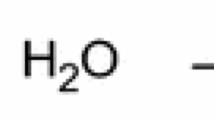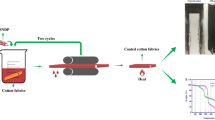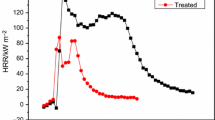Abstract
The effect of ammonium sulfate (NH4)2SO4 on the flammability of 100% cotton woven fabric (plain 144 g m−2, the number of yarns 21 per 10 mm) has been of interest in this study. The laundered bone-dried, massed fabrics were impregnated with suitable concentration of aqueous ammonium sulfate solutions by means of squeeze rolls, drying and conditioning. Afterwards the specimen’s resistance to burning has been determined. The optimum add-on value of ammonium sulfate to impart flame-retardancy to cotton fabric was in a range about 10.55–13.62 g anhydrous salt per 100 g fabric.
Thermogravimetry (TG/DTG) of the pure cotton and the treated one with the above-mentioned sulfate as well as for pure salt were also accomplished and their TG curves were compared and commented to detect the combustion’s pathway of the supported substrate. TG data confirm major mass loss in treated cotton. It occurred well below at a punctual duration of the thermal degradation zone of the polymer. So fewer flammable volatiles and more char could be produced during combustion. The results obtained are in compliance with gas dilution theory and also chemical action theory.
Similar content being viewed by others
References
G. Zhang, A. H. Lee, H. C. Lee and M. Clinton, Fire Safety J., 41 (2006) 57.
D. J. Irvine, J. A. McCluskey and I. M. Robinson, Polym. Degrad. Stab., 67 (2000) 383.
M. Alaee, P. Arias, A. Sjodin and A. Bergma, Env. Inter., 29 (2003) 683.
J. L. Jurs and J. M. Tour, Polym. J., 44 (2003) 3709.
V. J. FernandesJr., N. S. Fernandes, V. M. Fonseca, A. S. Araujo and D. R. Silva, Thermochim. Acta, 388 (2002) 283.
H. Demir, E. Arkiş, D. Balkőse and S. Űlkű, Polym. Degrad. Stab., 89 (2005) 478.
A. K. De, A Textbook of Inorganic Chemistry, Wiley Eastern Ltd., New Delhi 1983, pp. 299, 675.
Academic Press Dictionary of Science and Technology, London 1991, p. 1296.
J. Pérez, E. Pérez, B. Vas, L. García and J. L. Serrano, Thermochim. Acta, 443 (2006) 231.
K. N. Upadhyaya, ’A Textbook of Inorganic Chemistry’, Vikas Publishing House, New Delhi 2002, p. 421.
S. Liodakis, D. Vorisis and I. P. Agiovlasitis, Thermochim. Acta, 444 (2006) 41.
S. M. Mostashari and Y. Kamali Nia, The accepted article No: 7907 due to be published in The Journal of Thermal Analysis and Calorimetry, (2007).
S. M Mostashari, J. Appl. Fire Sci., 13 (2004–2005) 1.
S. M Mostashari, J. Appl. Fire Sci., 13 (2004–2005) 355.
S. M. Mostashari, Intern. J. Chem., 13 (2003) 115.
S. M. Mostashari and O. Baghi, J. Appl. Fire Sci., 12 (2003–2004) 203.
S. M. Mostashari, M. A. Zanjanchi and O. Baghi, Combustion, Explosion Shock Waves, 41 (2005) 426.
S. M. Mostashari, Asian J. Chem., 17 (2005) 434.
S. M. Mostashari and M. R. Babaei Chaijan, Asian J. Chem., 17 (2005) 1469.
S. M. Mostashari and S. M. Golmirzadeh, Asian J. Chem., 17 (2005) 2007.
S. M. Mostashari and A. Darsaraei, Intern. J. Chem., 15 (2005) 89.
S. M. Mostashari and A. Farkhondeh, Asian J. Chem., 17 (2005) 2803.
S. M. Mostashari and S. Z. Mostashari, Asian J. Chem., 17 (2005) 2331.
S. M. Mostashari, H. Haddadi and Z. Hashempoor, Asian J. Chem., 18 (2006) 2388.
S. M. Mostashari, R. Amirrahmat and A. Farkhondeh, Asian J. Chem., 18 (2006) 2391.
S. M. Mostashari, Y. Kamali Nia, S. Z. Mostashari and A. Darsaraei, Fire Safety, Technology Management, 9 (2007) 23.
T. Hatakeyama and Z. Liu, ’Handbook of Thermal Analysis’, John Wiley and Sons, Chichester 1998, p. 17.
P. Zhu, S. Sui, B. Wang, K. Sun and G. J. Sun, Anal. Appl. Pyrol., 71 (2004) 645.
S. M. Mostashari, M. Phil. Thesis, University of Leeds 1978, p. 4.
M. Kesner and W. J. Vos. De, J. Chem. Educ., (2001) 41.
J. H. Troitizsch, ’Overview of Flame-retardant’, Chimica Oggi/Chemistry Today, (1998), p. 16.
A. R. Horrocks, ’An Introduction to the Burning Behavior of Cellulosic Fibers’, JSDC, 99 (1983) 191.
W. A. Reeves and M. A. Hammons, Text. Res. J., 50 (1980) 245.
Author information
Authors and Affiliations
Corresponding author
Rights and permissions
About this article
Cite this article
Mostashari, S.M., Mostashari, S.Z. Combustion pathway of cotton fabrics treated by ammonium sulfate as a flame-retardant studied by TG. J Therm Anal Calorim 91, 437–441 (2008). https://doi.org/10.1007/s10973-007-8332-0
Received:
Accepted:
Published:
Issue Date:
DOI: https://doi.org/10.1007/s10973-007-8332-0




